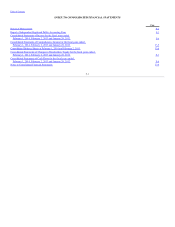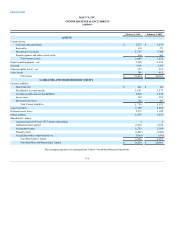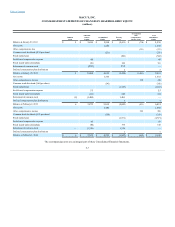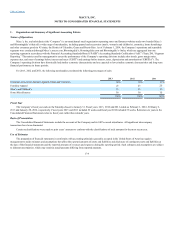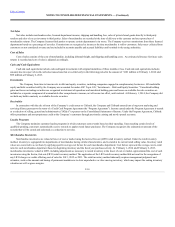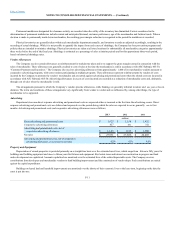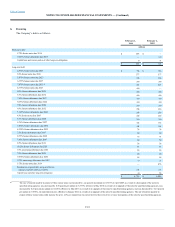Macy's 2013 Annual Report Download - page 57
Download and view the complete annual report
Please find page 57 of the 2013 Macy's annual report below. You can navigate through the pages in the report by either clicking on the pages listed below, or by using the keyword search tool below to find specific information within the annual report.
Table of Contents
Permanent markdowns designated for clearance activity are recorded when the utility of the inventory has diminished. Factors considered in the
determination of permanent markdowns include current and anticipated demand, customer preferences, age of the merchandise and fashion trends. When a
decision is made to permanently mark down merchandise, the resulting gross margin reduction is recognized in the period the markdown is recorded.
Physical inventories are generally taken within each merchandise department annually, and inventory records are adjusted accordingly, resulting in the
recording of actual shrinkage. While it is not possible to quantify the impact from each cause of shrinkage, the Company has loss prevention programs and
policies that are intended to minimize shrinkage. Physical inventories are taken at all store locations for substantially all merchandise categories approximately
three weeks before the end of the fiscal year. Shrinkage is estimated as a percentage of sales at interim periods and for this approximate three-week period,
based on historical shrinkage rates.
Vendor Allowances
The Company receives certain allowances as reimbursement for markdowns taken and/or to support the gross margins earned in connection with the
sales of merchandise. These allowances are generally credited to cost of sales at the time the merchandise is sold in accordance with ASC Subtopic 605-50,
“Customer Payments and Incentives.” The Company also receives advertising allowances from approximately 1,000 of its merchandise vendors pursuant to
cooperative advertising programs, with some vendors participating in multiple programs. These allowances represent reimbursements by vendors of costs
incurred by the Company to promote the vendors’ merchandise and are netted against advertising and promotional costs when the related costs are incurred in
accordance with ASC Subtopic 605-50. Advertising allowances in excess of costs incurred are recorded as a reduction of merchandise costs and, ultimately,
through cost of sales when the merchandise is sold.
The arrangements pursuant to which the Company’s vendors provide allowances, while binding, are generally informal in nature and one year or less in
duration. The terms and conditions of these arrangements vary significantly from vendor to vendor and are influenced by, among other things, the type of
merchandise to be supported.
Advertising
Department store non-direct response advertising and promotional costs are expensed either as incurred or the first time the advertising occurs. Direct
response advertising and promotional costs are deferred and expensed over the period during which the sales are expected to occur, generally one to four
months. Advertising and promotional costs and cooperative advertising allowances were as follows:
Gross advertising and promotional costs $1,623
$1,554
$1,432
Cooperative advertising allowances 457
431
372
Advertising and promotional costs, net of
cooperative advertising allowances $1,166
$ 1,123
$ 1,060
Net sales $27,931
$27,686
$26,405
Advertising and promotional costs, net of cooperative
advertising allowances, as a percent to net sales 4.2%
4.1%
4.0%
Property and Equipment
Depreciation of owned properties is provided primarily on a straight-line basis over the estimated asset lives, which range from fifteen to fifty years for
buildings and building equipment and three to fifteen years for fixtures and equipment. Real estate taxes and interest on construction in progress and land
under development are capitalized. Amounts capitalized are amortized over the estimated lives of the related depreciable assets. The Company receives
contributions from developers and merchandise vendors to fund building improvement and the construction of vendor shops. Such contributions are netted
against the capital expenditures.
Buildings on leased land and leasehold improvements are amortized over the shorter of their economic lives or the lease term, beginning on the date the
asset is put into use.
F-11


